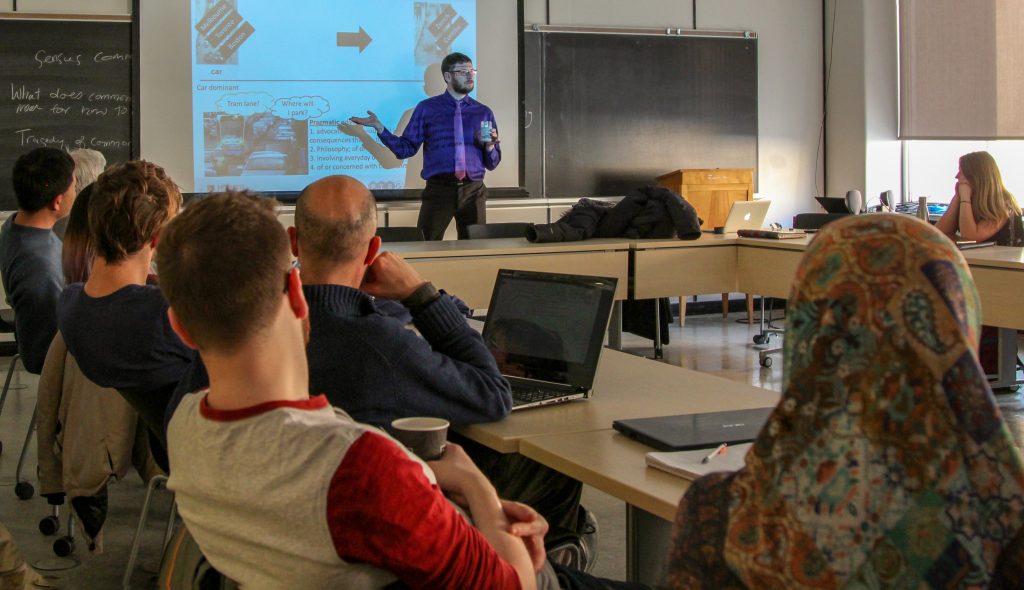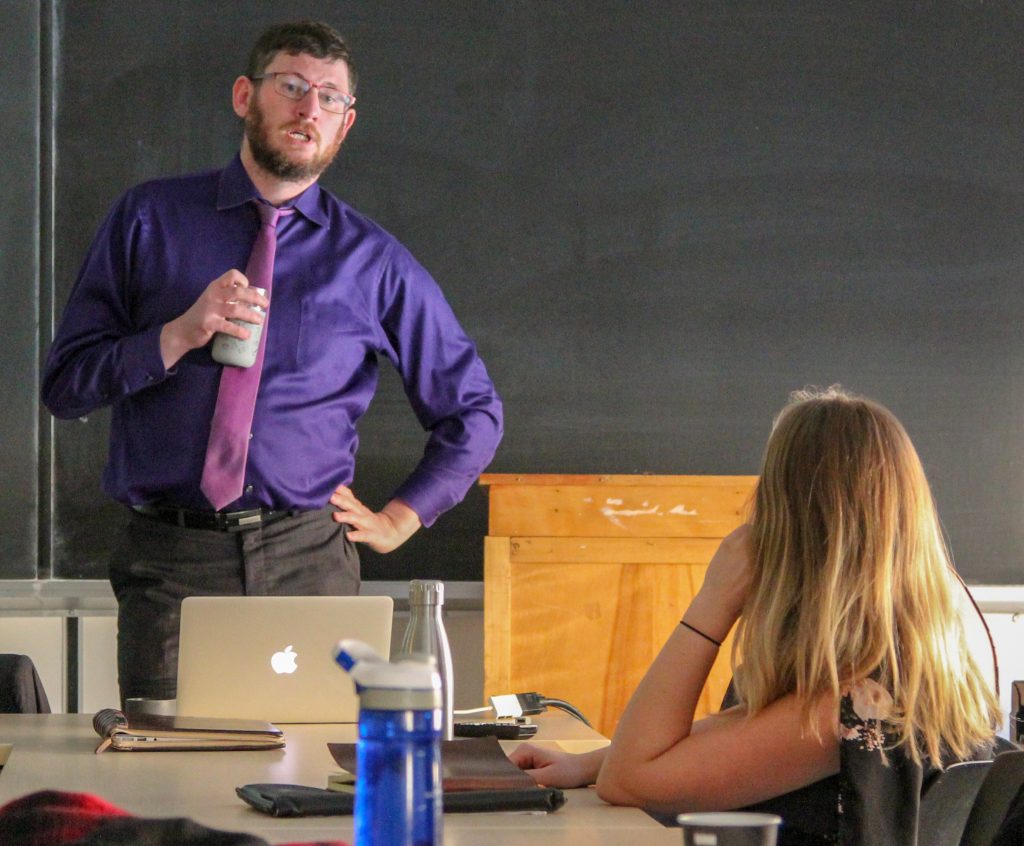
Guest speaker James Reynolds began his talk “Public Transport Priority, Politics and Legitimacy; Strategic Frameworks for Pragmatic Implementation in Car-centric Cities” by comparing Toronto to Melbourne. He’s lived in both cities and thinks they are quite similar, transit-wise.
Reynolds’ January 25 talk at Sidney Smith Hall was peppered with many real-life examples of small steps that cities can take to introduce changes that prioritize transit. The strategy of least resistance is used in many parts of the world.
Pop ups and pilots are two examples of experiments that are easier to start, and often well tolerated because of their temporary nature. If the change doesn’t work out, it’s easy to re-set, and it gives stakeholders an opportunity to try it out before making any change permanent.

Abstract
Transit priority measures allocate road space or intersection time to streetcars and buses to improve the speed and reliability of on‐road transit services.
Examples of priority measures include:
- transit signal priority systems;
- bus lanes; and
- curb-separated streetcar tracks.
Streetcars and buses have greater people-carrying capacity than private vehicles, which is a strong justification for prioritizing transit in busy urban environments where road space is in limited supply.
Unfortunately, the introduction of transit priority measures can reduce the level of service for other road users, or may require the removal of on-street parking. In democratic countries the allocation of road space and intersection time is ultimately under the control of the voters. Therefore, political and public support is usually needed for transit priority to be implemented and retained over the longer term, and this is a considerable obstacle in car-centric cities. However, this has not been a focus of transit priority research. Instead, research has mostly focused on the evaluation of traffic, economic or other technical aspects of transit priority measures.
VicRoads is the state road authority in Melbourne, Victoria, and has co-sponsored a PhD project to examine transit priority implementation from a public policy analysis perspective. This project is part of the Sustainable and Effective Public Transport Graduate Research Industry Partnership (SEPT-GRIP) at Monash University. The project was started in April 2017, and is now in its third year.
Case-study-based research to date has led to the development of two new frameworks that consider how legitimacy influences transit priority implementation. The research has considered transit priority implementation in:
- Zürich (Switzerland);
- Curitiba (Brazil);
- Melbourne (Australia);
- Toronto (Canada); and
- Boston (USA).
Recent events in these cities provide a range of successful and not-so-successful outcomes, as well as various different political and institutional conditions surrounding transit priority projects and programs.
The two new frameworks suggest that implementing transit priority is inherently more difficult in Melbourne, Toronto and similarly car-centric cities. Zürich and Curitiba have undertaken major programs to prioritize transit, but similar approaches have not succeed elsewhere due to a lack of legitimacy for providing high levels of transit priority in other cities.
Despite this gloomy outlook, the case study research to date has identified five pragmatic strategies that are being successfully used to implement transit priority measures in car-centric cities. These strategies are:
- subservient priority;
- grade‐separation;
- bottom‐up and incremental implementation;
- trials or pop‐ups; and
- formal processes and public enquiry approaches.
This presentation provides an outline of the two new frameworks for transit priority legitimacy, and discusses examples of the pragmatic strategies that have been successfully used in various car-centric cities to implement transit priority measures. Marsden and Reardon (2017) called for greater consideration of “context, politics, power, resources and legitimacy” in the study of transportation policy. The research discussed in this presentation responds in part to Marsden and Reardon’s call, by identifying ways that transit can be prioritized in places where there is limited political and institutional support for changes that might negatively impact on private vehicles.

James Reynolds completed a Bachelor of Engineering (Civil) (Hons) and a Diploma of Music (Prac) at the University of Melbourne in 2004, and a Master of Traffic and a Master of Transport at Monash University in 2010. He is a licensed engineer and has over ten years of experience in consulting in the areas of road safety, transportation planning and traffic engineering in both Melbourne and Toronto.
James worked at BA Group in Toronto from 2011 to 2014, but is now back in Melbourne undertaking a PhD with the Public Transport Research Group (PTRG) at Monash University. His PhD is supervised by Professor Graham Currie, Professor Geoff Rose and Alistair Cumming. It is one of the 18 projects in the SEPT-GRIP, which is jointly funded by Monash University and industry groups including Transport for Victoria, Metro Trains Melbourne, Yarra Trams, VicRoads, Transdev Melbourne and the Bus Association of Victoria.
View James Reynold’s presentation file “Public transport priority, politics and legitimacy; strategic frameworks for pragmatic implementation in car centric cities” on Google Drive.
This seminar was co-presented by the University of Toronto Intersections Speaker Series, Department of Geography and Planning, and the University of Toronto Transportation Research Institute (UTTRI).
